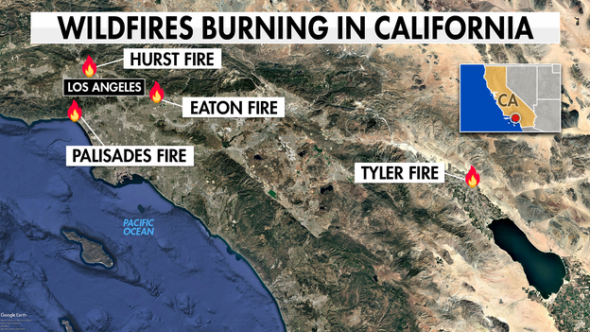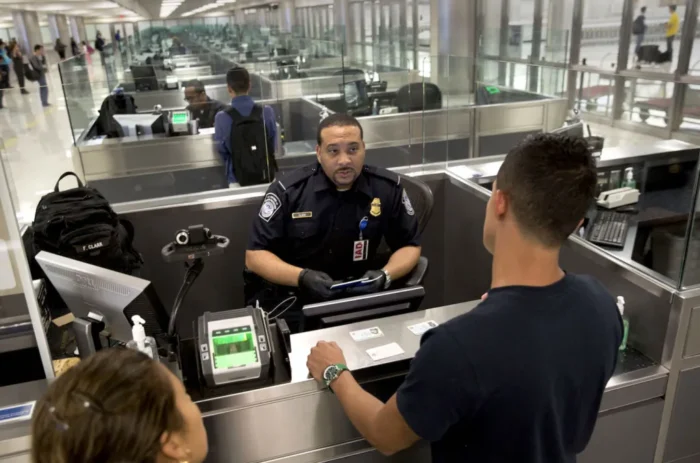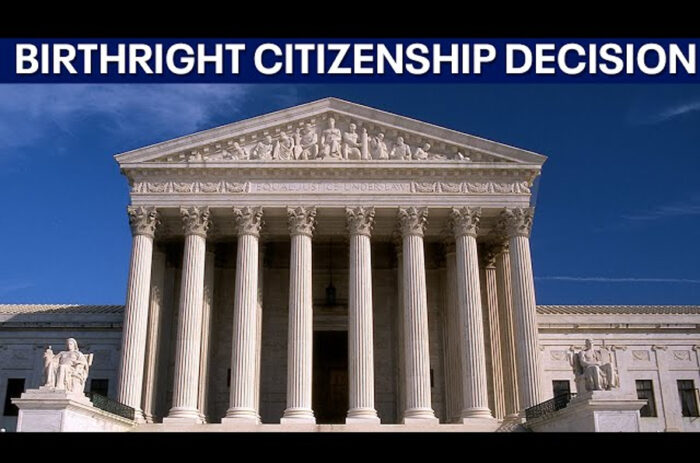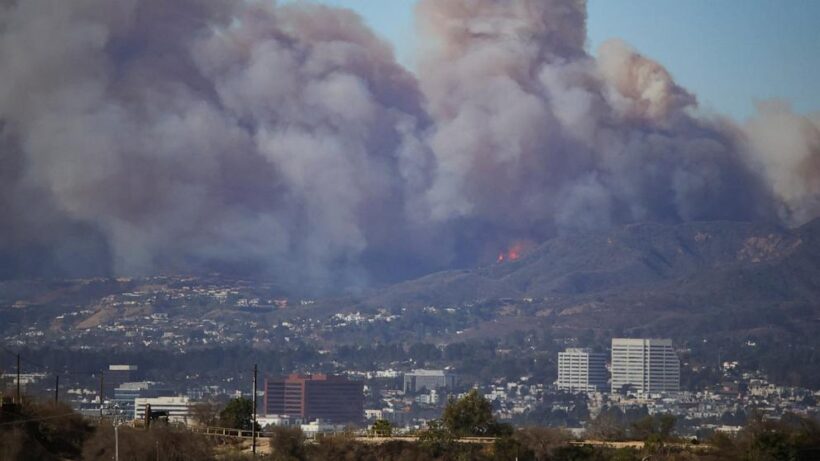
Smoke rises from a wildfire burning near Pacific Palisades on the west side of Los Angeles during a weather driven windstorm, in Los Angeles, California, January 7, 2025. (Reuters/Daniel Cole)
redo Jump to...
print Print...
(Los Angeles Times) – More than a thousand homes, businesses and other buildings have burned and at least two people are dead in wildfires burning across L.A. County, making this one of the most destructive firestorms to hit the region in memory.
In Pacific Palisades, the Palisades fire had charred more than 5,000 acres as of Wednesday morning, burning down to Pacific Coast Highway where it engulfed homes along the iconic stretch. About 1,000 structures, including many homes, have been destroyed in the fire, Los Angeles County Fire Chief Anthony Marrone said during a press conference Wednesday morning. [The fire remains 0% contained as of Wednesday afternoon.]
The Eaton fire, which broke out Tuesday evening, had burned more than 2,200 acres near Altadena and Pasadena whipped by gusts of up to 99 mph in the area. Two people have died in the Eaton fire and several others have been seriously injured in both the Eaton and Palisades fire, Marrone said.
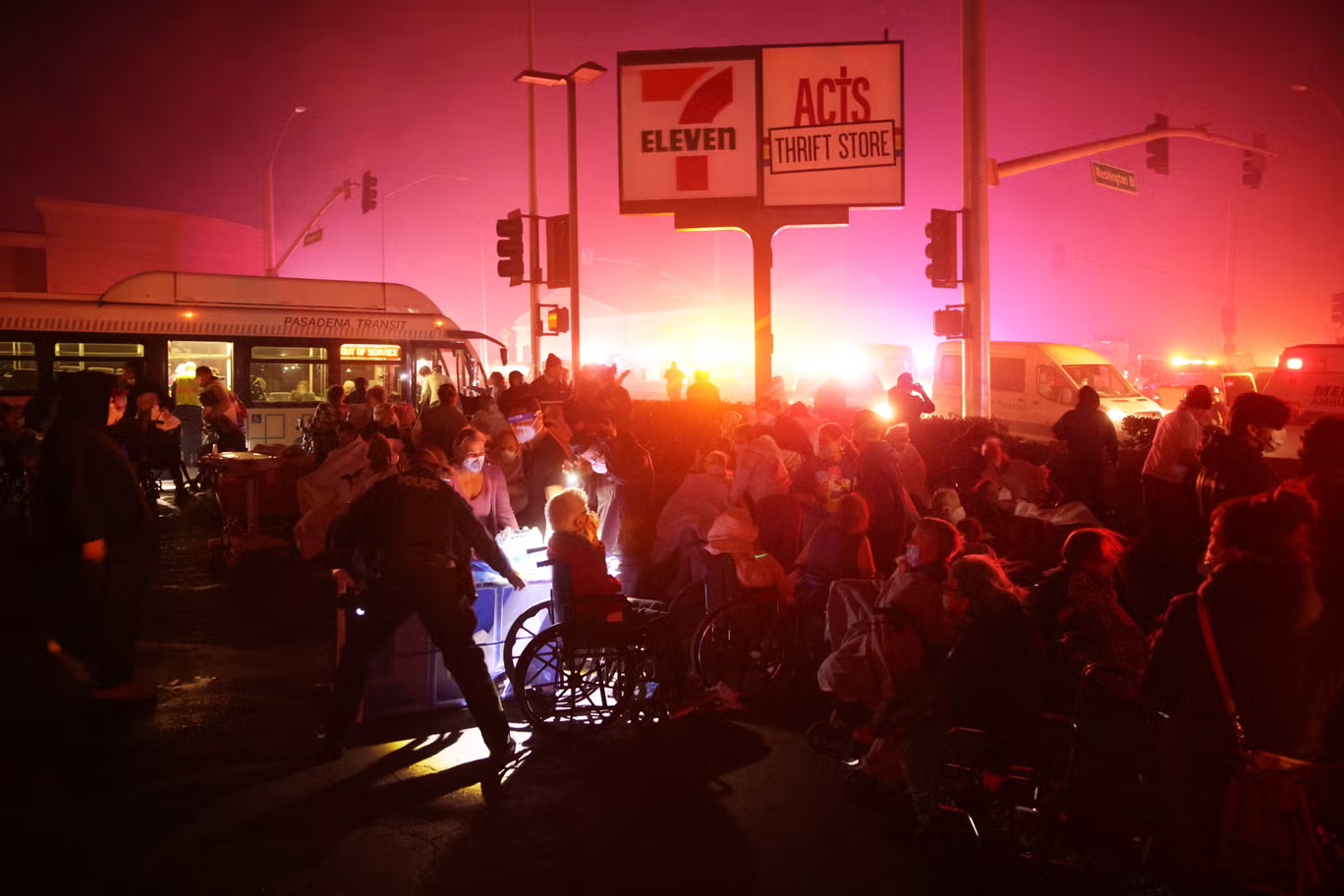
Residents of a senior center are evacuated as the Eaton Fire approaches Tuesday in Altadena. The flames, paired with the glow of emergency vehicles, have created a Mars red sky over the region, where an estimated 100,000 people are under evacuation orders. In Altadena alone, roughly 42,000 residents were forced to evacuate, according to the Washington Post. (AP)
The Hurst fire, which spread quickly during high winds overnight in Sylmar, had burned 500 acres. Extraordinarily powerful winds and gusts — of up to 99 mph — had been reported overnight.
On Wednesday, firefighters were bracing for another challenging day of fire fueled by strong winds. Red flag warnings [warning of extreme fire danger; warning of high fire danger with increased probability of a quickly spreading vegetation fire in the area within 24 hours] remain in effect for Los Angeles County and much of Ventura County through Thursday with officials warning of a “life threatening, destructive and widespread windstorm.”
“We are absolutely not out of danger yet,” Los Angeles Fire Department Chief Kristin Crowley said.
The National Weather Service reported a gust of 99 mph near Altadena at 10:20 p.m. Tuesday; 98 mph near Woodland Hills at 9:37 p.m.; and 84 mph at Hollywood Burbank Airport at 8:30 p.m.
The National Weather Service has warned of a “particularly dangerous situation” across the San Gabriel Mountains, Beverly and Hollywood Hills, the coastal areas adjacent to the Sepulveda Pass, the Santa Monica Mountains, Malibu and the eastern Ventura Valley.
NWS meteorologist Rich Thompson said this could be the strongest such wind event since the 2011 windstorm that caused serious damage in Pasadena, Altadena and other San Gabriel Valley neighborhoods, knocking out power for days for more than 400,000 people. The 2011 windstorm caused at least $40 million in damage, according to a preliminary estimate.
“If it does develop, it can cause very specific damage,” Thompson said before this week’s fires broke out. “Imagine like a wave in the water. … Those winds kind of go down slope, then just hit the surface and get very strong.”
In Pacific Palisades, firefighters grappled with wind gusts up to 100 mph overnight bedeviling their efforts to get the blaze—burning both east and west—under control, said Los Angeles Fire Capt. Erik Scott.
“The fire is being fueled by strong Santa Ana winds and surrounding topography, which makes it extremely challenging for us firefighters to really get a handle on it,” Scott said. “Our priority is life and structure defense.”
On Tuesday night, increasing winds made an air attack against the wildfires impossible. Fearsome winds forced crews to ground aircraft in the battle against the Palisades fire shortly before 8 p.m. Tuesday.
About two hours earlier, the Eaton fire broke out in the hills above Altadena near Eaton Canyon. Strong winds led officials to suspend air coverage of the Eaton fire for the evening, officials said at 8:45 p.m.
The lack of rain has extended the fire season in Southern California. Since Oct. 1, the beginning of the water year, downtown Los Angeles has received 0.16 inches of rain — a tiny fraction of the 4.64 inches that downtown gets, on average, by this point in the season.
By contrast, Northern California hasn’t faced such fire weather, with rainfall at above-average levels. Downtown San Francisco has received 10.39 inches of rain since Oct. 1 — above the 9.29 inches of rainfall the city gets on average by this point in the season.
“Southern California has experienced a particularly hot summer, followed by almost no precipitation during what is normally our wet season,” said Alex Hall, director of the UCLA Center for Climate Science. “And all of this comes on the heels of two very rainy years, which means there is plenty of fuel for potential wildfires.”
Extreme fire conditions were expected to continue through the middle of Wednesday afternoon, the weather service said after midnight Wednesday. “Any wildfires that start will likely spread rapidly with extreme fire behavior,” the weather service said.
Another Santa Ana wind event is expected for Friday. But it is expected to be “more typical,” the NWS said, with winds forecast to come from the northeast “focused along the typical Santa Ana wind corridor, from the Santa Clarita Valley to Point Mugu. … The downsloping winds will also reduce the humidities and increase the fire danger.”
The weather service warned that winds “will be gusty and erratic, with lulls between gusts.”
Published at Los Angeles Times on Jan. 8, 2024, 10:40 a.m. Reprinted here for educational purposes only. May not be reproduced on other websites without permission. Written by Grace Toohey, Clara Harter, Noah Haggerty, Rong-Gong Lin II, Hannah Fry.
from the UK Independent:
What is causing the fires?
The fast-moving wildfires are being fueled by a weather phenomenon known as the Santa Ana winds.
The Santa Anas are dry, warm and gusty northeast winds that blow from Nevada and Utah to Southern California toward the coast. They move in the opposite direction of the normal onshore flow that carries moist air from the Pacific into the region.
The name is understood to be linked to Santa Ana Canyon in Orange County, but the weather has other nicknames such as “devil winds” or “red wind.”
LAFD officials said they are bracing themselves for the bruising winds to reach gusts of up to 60 mph through Thursday. In some parts, the Santa Anas could reach speeds of up to 100 mph, according to the National Weather Service.
The weather service has issued an extreme weather warning of a life-threatening and destructive windstorm for some areas.
Questions
1. How many structures have burned since the wildfires started yesterday?
2. How much of the fire has been contained as of Wednesday afternoon?
3. What has caused the fires to spread so quickly?
4. a) What are red flag warnings?
b) How long are the red flag warnings expected to last?
5. Why aren’t firefighters able to use aircraft to fight these fires?
6. Why isn’t northern California experiencing the wildfires affecting southern California?
7. List some of the challenges firefighters and rescue workers face in general when faced with these fast moving, widespread wildfires.
Background
From a Jan. 8 LA Times article by Summer Lin:
Orly Israel and his family evacuated from their home in Pacific Palisades on Tuesday morning.
He and his friend Tanner Charles then drove up the biggest hill in the neighborhood and spent about 45 minutes watching the inferno.
“It’s like when you’re sitting next to a bonfire and the wind picks up and all the smoke and ash gets blown into your face. It’s like that except the entire world,” Israel said. “It was like what I would imagine hell would be like.”
Charles, who has been a storm chaser for nearly 16 years, said he’s never experienced anything like the Palisades fire before.
“It was loud,” he said. “We’d hear so many explosions in the neighborhood, propane tanks exploding. It was just insane.”
Eventually, the smoke got so thick that the two decided to go back to Israel’s house and try to protect it from the flames. Israel was spraying down the backyard, including bushes and trees, with a garden hose while Charles sprayed the front of the house. They pulled anything plastic indoors.
Palm trees caught on fire around them, exploding into columns of flames and showering the earth with sparks. Orly and Charles met inside the house just in time to see the entire backyard engulfed within 10 seconds.
“Let’s get out of here. We tried our best,” Charles said in a video later posted on his X account.
As of Wednesday morning, 30 year old Israel still doesn’t know if his family lost their house but heard that several houses on the street had been engulfed in flames. His house’s chances for remaining unscathed seemed grim.
“I haven’t been able to understand the kind of devastation we see all over the world with crises and natural disasters,” Israel said. “There is this surreal concept of ‘Home is where the heart is.’ Since we’re OK physically, we’re going to be OK.”
Israel said his family likely lost musical instruments and their collection of art that they’d been gathering for several years. Israel is staying with a friend in Culver City until they find out more information about their home.
“The most meaningful outcome of this is that so many people who have seen what I’ve gone through reached out to me and my family,” he added. “It’s giving me hope that not all is lost.”
Resources
See maps and info at the Cal Fire website.
The National Weather Service issues the Red Flag warnings. Visit the website here.
Read “Red Flag Warnings” at International Association of Fire Chiefs website.
Read “5 Strategies on How to Prevent Wildfires in California” from the Western Fire Chiefs Association.
Visit the National Weather Service.
Daily “Answers” emails are provided for Daily News Articles, Tuesday’s World Events and Friday’s News Quiz.
